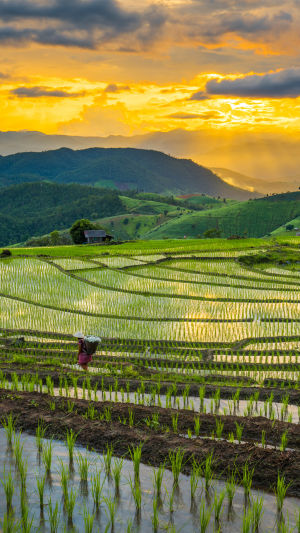Dear Lykkers! Rice terraces are a breathtaking sight, particularly in Thailand, where they serve not only as agricultural fields but also as a testament to the ingenuity, resilience, and culture of local communities
These terraces, carved into the mountainsides, reflect the harmony between humans and nature, showcasing sustainable farming practices that have been passed down through generations.
<h3>Cultural Significance</h3>
The rice terraces of Thailand are deeply woven into the culture and traditions of local communities. Rice, a staple in Thai cuisine, holds immense significance, with its cultivation often accompanied by rituals and festivals celebrating the harvest season. Ethnic groups such as the Hmong, Akha, and Karen have unique customs surrounding rice farming, enriching these landscapes with cultural depth and diversity. These terraces symbolize not only agricultural innovation but also the deep spiritual and cultural connection that these communities have with the land.
Spectacular rice terrace fields of Vietnam
Video By The Hindu
<h3>How Rice Terraces are Made</h3>
Creating rice terraces is a labor-intensive process that involves several key steps:
<b>1. Selecting the Site</b>
Farmers choose sloped land with good access to sunlight and water, as these are crucial for rice cultivation. The ideal site also has fertile soil that can support the growth of rice plants.
<b>2. Clearing and Preparing the Land</b>
The selected area is cleared of vegetation, and the soil is tilled to prepare for planting. In many traditional communities, this process is still done manually using simple tools passed down through generations.
<b>3. Carving the Terraces</b>
Workers carve level steps into the hillside, ensuring each terrace is slightly lower than the one above it. This technique allows water to flow gently down from one level to the next, aiding in both irrigation and water retention.
<b>4. Building Retaining Walls</b>
To prevent soil erosion, stone or mud walls are constructed along the edges of each terrace. These retaining walls hold the soil in place, ensuring the terraces remain stable, even during heavy rainfall.
<b>5. Flooding the Terraces</b>
Once the terraces are complete, they are carefully flooded with water, creating the ideal conditions for rice planting. Water management is crucial, ensuring that each terrace receives the right amount of water for optimal growth.
<b>6. Planting Rice</b>
Farmers typically germinate rice seeds before transplanting them into the flooded terraces. This method, known as “wet rice cultivation,” helps improve yields by providing the rice plants with the water they need from the start.
<b>7. Harvesting</b>
After several months of growth, the rice is ready for harvest. Harvesting is often accompanied by a sense of celebration, with the entire community coming together to mark the occasion in a festive atmosphere.
<h3>Visiting the Rice Terraces</h3>
For travelers, Thailand's rice terraces offer a chance to witness the stunning beauty of the country's natural landscapes while immersing themselves in local culture. Many visitors explore these areas by hiking or biking, with guided tours available to provide deeper insights into the agricultural practices and traditions of the region. The best time to visit is during the rainy season (June to October), when the terraces are flooded, creating a mesmerizing mirror-like effect that enhances their beauty and charm.
<h3>Photography Opportunities</h3>
The rice terraces offer a dreamlike backdrop for photography enthusiasts. The interplay of light, water, and lush greenery, particularly during sunrise and sunset, creates breathtaking views often described as otherworldly. Photographers are drawn to locations such as Doi Inthanon National Park in Thailand and Sapa in Vietnam for stunning landscape shots. These terraces, with their layered structure and reflection of the sky, make for captivating photographs that capture the essence of rural life and natural beauty.
The rice terraces of Thailand are much more than just agricultural fields; they represent a harmonious blend of natural beauty and cultural heritage. These terraces exemplify sustainable farming practices while offering vital economic support to local communities. Whether you’re an adventure seeker, a culture enthusiast, or a photography lover, the rice terraces are a must-visit destination in Thailand, showcasing the stunning interplay between nature and human ingenuity. The craftsmanship and effort involved in creating these terraces highlight the resilience and innovation of the farmers who have shaped this picturesque landscape for generations





